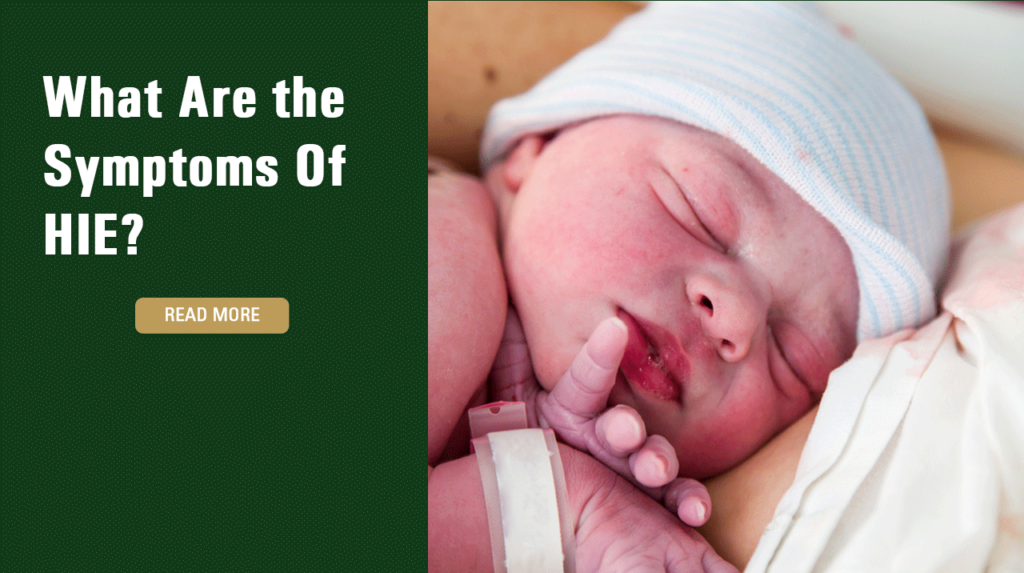What Are the Symptoms Of HIE?

Hypoxic-ischemic encephalopathy (HIE) is a serious birth injury that can have permanent and devastating consequences. HIE can develop when an infant’s blood flow and oxygen supply to the brain are cut off for a prolonged period, resulting in damage to the brain. If HIE is not promptly identified and treated, children might suffer lifelong disabilities, including cerebral palsy and/or intellectual disabilities, that can require a lifetime of care. It is important for doctors to promptly identify the signs of fetal distress so that they can intervene to prevent HIE and its complications.
Symtpoms Of Distress During Pregnancy
The oxygen supply to the fetus’s brain can be disrupted during pregnancy and lead to HIE. The symptoms can be identified by health care professionals during ultrasounds performed during any trimester. Fetal distress signs can indicate hypoxia and might include abnormal movements or heart rates that can be identified and treated.
Doctors should also monitor mothers and infants to watch for these additional symptoms that might indicate HIE during pregnancy:
- Maternal high blood pressure
- Minimal movement of the fetus
- Unusual patterns of contraction
- Extreme maternal cramping of the back
- Excessive vaginal bleeding
- Extreme maternal weight fluctuations
Several risk factors might be present when women have high-risk pregnancies. Any woman who is older can be considered to have a high-risk pregnancy. Those who have experienced previous C-sections or birth complications might also have high-risk pregnancies. When a woman’s pregnancy is high-risk, her doctor should take added care to ensure the baby and mother are both closely monitored throughout pregnancy. Certain issues with the placenta, including placental insufficiency and abruption, can also cause HIE. These placental problems can happen both before and during labor. These problems can cause the placenta to be malformed or to dislodge from the uterus, causing an interruption of the flow of oxygen and blood to the infant. Doctors might be able to identify placental problems early to intervene before the fetus is harmed.
Symptoms Of HIE During Labor And Delivery And After Birth
Brain injuries to the infant can happen during labor and delivery because of a variety of complications. Mothers who have had previous C-sections can suffer uterine rupture, which can deprive the babies of oxygen. Emergency C-sections might be necessary to restore the baby’s oxygen supply and blood flow.
Another common issue during labor and delivery that can interfere with the baby’s oxygen and blood supply occurs when the umbilical cord is compressed. The umbilical cord can be trapped between the baby and the mother’s pelvic wall, causing it to become compressed. Umbilical cord compression can cut off the baby’s oxygen supply and cause a brain injury or HIE.
Some of the symptoms of a disruption in the baby’s oxygen and blood supply during labor and delivery include the following:
- Acidemia
- Coma
- Prematurity
- Organ damage
- Feeding problems
- Hyper-alertness
- Seizures
- Lack of a response to light
- Extreme lethargy
- Trouble breathing
- Hypotonia
- Low APGAR score five minutes or more after birth

If a baby’s APGAR score is very low, or the other symptoms are noticeably present, the doctor might cool the baby’s body temperature to slow the spread of brain damage by using therapeutic hypothermia. Cooling the infant’s body temperature helps to stop brain cell death and the release of toxins that can cause further damage.
Understanding The APGAR Score
The APGAR is a test that checks the baby’s condition and appearance to identify signs of HIE. It is typically performed immediately after every birth to check the newborn baby’s condition. The doctor will check the baby’s heart rate, degree of paleness, muscle tone, breathing, and reflexes. Babies who have HIE might have bluish or pale skin, a lack of reflexes, and a low heart rate. Some babies might also have trouble breathing and a lack of muscle tone. If the infant’s low APGAR score doesn’t improve within five minutes, HIE or another birth injury might be diagnosed. In some children with HIE, however, the condition might not be detected with the APGAR test.
Symptoms Of HIE In Childhood
If HIE is not diagnosed within 24 hours of a baby’s birth, it might not be diagnosed until the child grows older and begins to miss some of the developmental milestones. Some children will not show obvious signs of HIE immediately following birth.
Some symptoms that a child might have suffered from HIE when he or she was born include the following:
- Seizures
- Severe impairments of the child’s motor skills
- Not meeting developmental milestones or meeting them late
- Problems with growth
- Visual and hearing impairments
- Difficulty crawling, moving, or walking
- Diagnosis of cerebral palsy
Get Help From A Child Injury Lawyer At Raynes & Lawn
If your child suffered HIE during or after birth and developed additional complications and disabilities as a result, you should speak to a birth trauma attorney at Raynes & Lawn. If your child’s condition was caused by the negligence of a doctor or another medical provider, you might be entitled to recover compensation for your losses. Contact us today at 1-800-535-1797 to request a free consultation.

For the general public: This Blog/Website is made available by the law firm publisher, Raynes & Lawn, for educational purposes. It provides general information and a general understanding of the law but does not provide specific legal advice. By using this site, commenting on posts, or sending inquiries through the site or contact email, you confirm that there is no attorney-client relationship between you and the Blog/Website publisher. The Blog/Website should not be used as a substitute for competent legal advice from a licensed attorney in your jurisdiction.
For attorneys: This Blog/Website is informational in nature and is not a substitute for legal research or a consultation on specific matters pertaining to your clients. Due to the dynamic nature of legal doctrines, what might be accurate one day may be inaccurate the next. As such, the contents of this blog must not be relied upon as a basis for arguments to a court or for your advice to clients without, again, further research or a consultation with our professionals.
